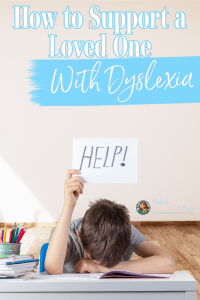Dyslexia. A neurodivergent learning disability that influences a person’s reading, writing, and spelling skills. The diagnosis often comes with a bad reputation. Dyslexic people are often labeled as illiterate, unintelligent, stupid, and worse.
I was diagnosed with dyslexia between the ages of five and seven, although I didn’t understand the diagnosis until I was 29. Despite being in public school, I had no interventions or extra help to correct or even understand and cope with the problem. All public school had to offer was an IEP for time and a half while testing and frequent breaks, which was used until I graduated.
I’ve heard it all throughout life, both at school and in the workplace. “You’re stupid!” “You’re retarded!” “You can’t possibly be this dumb!” “You’ll never succeed in life!” Looking back, I laugh because my dyslexic ability has shaped my success today.
Notice how I said “my dyslexic ability” instead of disability? There’s a reason for that. With every weakness, there are strengths, even with dyslexia. We’re neurodivergent but not incapable! Let’s look at what dyslexia is and better understand how dyslexic minds work so you can better support your loved one’s unique gift.
Understanding Dyslexia
Dyslexia affects 20 percent of the population and impacts far beyond reading, writing, and spelling skills (1). If you read our blog, Understanding Dyslexia (From a Dyslexic Perspective), you know I learned about dyslexia from the book, The Gift of Dyslexia. This book not only shaped my understanding of dyslexia but transformed my learning disability from a weakness to a strength. I highly recommend this book to anyone with a dyslexic family member. The two biggest things I learned from this book were dyslexic disorientation and trigger words.
Dyslexic disorientation is a state of confusion that causes dyslexic people to experience distorted perceptions (2). Distorted perceptions can look different for everyone.
For some dyslexic people, the letters are constantly flickering around, and for others, the letters seem jumbled together (my distorted perception is jumbled). Here’s an example of distorted perception. These distorted perceptions make dyslexic people more susceptible to making mistakes in reading or spelling.
Every dyslexic person has a different confusion threshold; some are lower than others. A dyslexic person with a higher threshold is less easily confused and less frequently disoriented. This is why some dyslexic people can read and spell decently and slip through the cracks of public schools. It’s almost as if they’re high-functioning dyslexics. ‘
But what triggers dyslexic disorientation?
Dyslexic disorientation is often triggered by words, specifically trigger words. There are over 200 trigger words; a complete list can be found here. Trigger words cause the most confusion for dyslexic people and are commonly used words, like “it” and “the.” Most dyslexics can read long words but struggle with or completely skip over these simple words because we think in pictures, also known as a pictorial flow.
In other words, we can picture things like a hippopotamus in our head but cannot associate an image with the words “it” or “the.” Dyslexic people may see the sentence “We saw the hippopotamus at the zoo” and read it as “saw hippopotamus zoo,” which makes no sense.
Associating an image with trigger words enhances pictorial flow. Some dyslexic people correct this problem through the Davis Symbol Mastery process, which engages creativity to establish an associated picture (sculpted in clay) with each trigger word (3).
Aside from trigger words, additional dyslexic disorientation triggers include (2):
- Not enough rest
- Poor diet or not enough food
- Illness, pain, or injury
- Drugs or medicines
- Print size too small
- Print too faint
- Varying print styles and typefaces
- Loud noises
- Specific sounds
- Certain smells
- Poor lighting (can be too much or too little)
- Excess motion (whirling fans, dangling decorations)
- A change in the orderliness of the environment
- Furniture rearrangement
- Moving households
- Scheduling changes
- Time pressure (being rushed)
- Threats of punishment
- Family strife
- Fear
- A loss
- Anything that is a reminder of an unpleasant past experience
In my experience, understanding dyslexic disorientation and triggers has been game-changing. Knowing what I need and understanding how I get from one state of mind to the next has helped me understand not just my dyslexia but myself as a person. It has opened up doors for communicating and understanding that I missed out on the first 29 years of my life.
How to Support a Loved One With Dyslexia
Many didn’t understand my way of thinking throughout life, often leading to miscommunications and frustrations. I am not the only dyslexic to experience this. Many dyslexics find alternative paths easier than being part of a society that doesn’t wish to understand their learning techniques. The fear of not fitting in is likely why studies have found a relationship between dyslexia, homelessness, drug abuse, and crime (4,5).
As a dyslexic person, I am here to dismantle what you think you know about dyslexia. I hope to help you and your loved one understand and support the beauty of a dyslexic mind. We don’t need to be ashamed or be another statistic.
Support at Home
Myths have circulated that dyslexia is caused by a lack of reading at home; this is not true. Although supporting dyslexia starts at home and reading with your child is important, dyslexia is still an unpreventable neurological condition (6). Learning to read does not make dyslexia go away. Contrarily, making learning how to read fun and stress-free is crucial, especially for dyslexics.
I recommend reading with your child starting at a very young age. Read books with pictures and simple stories. Find what interests them, ensuring it’s fun. Try furthering their learning and talking about what the book was about. Don’t get mad if they don’t understand or are completely off base. Listen to their perspective because their mind is different. Dyslexic minds think differently. The perspectives we see are often far beyond what meets the neurotypical mind. Our differing perspectives are a strength, not a weakness.
Make sure you keep an open mind. Don’t be quick to dismiss thoughts or feelings on a subject. Ask questions to clarify and effectively communicate with your child (this will also teach them how to ask clarifying questions). Ensure you are kind and gentle. Ensure your child doesn’t feel less than or stupid for their way of thinking – this is crucial for dyslexic minds to flourish. It’s important not to push dyslexics to learn to read or read aloud (I will discuss this more in the next section).
Last, but definitely not least, be your child’s biggest supporter. Be their lifelong cheerleader. Support them every step of the way. Not everything they do will make sense to you, but instead of telling them “no,” ask them why they are doing things the way they are. You may learn a thing or two. What seems obvious or easier for you may be severely complicated and dreadful to the dyslexic mind. We often find a way to make it easier all on our own; we just need some support along the way.
Support at School
In my experience, public school didn’t offer me any support besides an IEP for time and a half and frequent breaks. I was given no further support for my dyslexia. I didn’t even know what dyslexia was; I just knew I had it. Looking back, I sure wish I’d have had more resources and an understanding of my diagnosis to better mold my future.
In public schools, the phonics method is most commonly used to learn how to read (7). We must remember that phonics reading will not work with dyslexic children. Actually, 35 years of evidence demonstrates that up to 25% of children cannot learn to read just by phonics, including most children with learning disabilities, including dyslexia (8).
Teaching a child to sound out a word when the words are busy shifting on the page is pointless. It’s like telling a child who’s been spinning in circles for two minutes straight to just stand still (they’re going to be wobbly). Not to mention, when a dyslexic child doesn’t understand the learning technique, they often memorize the words to avoid making mistakes. I was famous for this, especially when “learning” a second language.
Instead, focus on their way of learning. The dyslexic mind thinks in pictures, so we are often very artistic; that’s one of our biggest strengths – hone in on it. Use coloring, painting, clay/Play-Doh, and let their creativity mold their learning experience. Again, make it fun and engaging for them (even if you don’t understand it).
Most importantly, do not push the child to read, especially aloud. Most dyslexics already struggle with their self-esteem. They fear others will make fun of them for making mistakes others normally wouldn’t make. When a dyslexic mind is scared or anxious, they’re prone to dyslexic disorientation, setting them up for failure. Dyslexic disorientation makes them susceptible to mistakes and fearful of learning; we don’t want that.
Support in the Workplace
Finding dyslexic support in the workplace isn’t easy. Most dyslexics are uncomfortable sharing their diagnosis, often due to fear of rejection or judgment, and that is okay. Although I have not worked in every place of employment, getting dyslexia support wasn’t easy (although I never disclosed it until my current employment). I will say, I am lucky enough to be supported and understood at work. I am so very grateful for the support, but this is often not the case for dyslexics, so here are some things I’ve done to ensure I succeed in the workplace.
First and foremost, organization and structure. I love to organize everything and plan things. Since I work from home, I have to create my own structure, so I plan the day from beginning to end. I write things down and organize my goals and tasks weekly and monthly to stay focused. Since I am a writer, sometimes my job can trigger me, so I take frequent breaks. An alarm goes off on my phone every hour as a reminder to take a five-minute break. I usually take a quick walk or grab something to eat, which helps me not become overstimulated or disoriented.
For me, communication is key. I’m aware that I think differently and have a different thought process than most of my colleagues, so I clarify everything. I ask questions, often in multiple ways, to be absolutely sure I understand the tasks at hand. I like to let my superiors know exactly what I need to get my job done and how long it will usually take. I leave no room for those who need to know to not know. These measures have been taken as condescending in previous employments, but my current employer is aware of my dyslexia and knows this is how I process information.
When it comes to communication, this can be very hard for dyslexics. My words quickly become jumbled when frazzled, and I struggle to process or even remember what I am trying to say. This is why I often write down notes and gather my thoughts before presenting them to another person. Learning to communicate effectively with others and being clear on what is needed is vital, especially in the workplace. People don’t know what they don’t know, so be sure they know!
Additional Dyslexia Resources
A huge part of succeeding with dyslexia is having access to resources. Although my biggest resource has been the book, The Gift of Dyslexia, dyslexia isn’t a one size fits all. So here are a few other dyslexia resources:
- Bright Solutions for Dyslexia
- Davis Dyslexia Association International
- International Dyslexia Association
- National Center for Learning Disabilities







